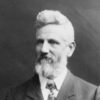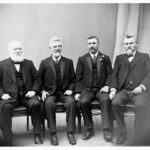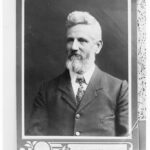Tom Price was born on the 19th January 1852 at Brymbo, North Wales, the son of stonemason John Price and his wife Jane (née Morris). His father’s intemperance forced him to start work at the age of nine and he became a stonemason. The Mechanics Institute and the Wesleyan Methodist Sunday Schools furthered his education and the Liberal Reform Association taught him much about politics and social reform.
On the 14th April 1881 he married Anne Elizabeth Lloyd. Poor health compelled him to emigrate and, with hopes of becoming a farmer, he paid his own way to South Australia. The family arrived in May 1883 and settled in Unley. Price took up work as a stonemason. It was he who cut the stone and shaped the capitals on the columns of the new Parliament House. Joining the Operative Masons’ and Bricklayers’ Society, he became its President in 1887 and its delegate in 1890 to the United Trades and Labour Council. He believed in a conciliatory approach to industrial relations but often spoke forcefully against injustice.
In 1891 he joined the fledging United Labor Party and was elected to the House of Assembly seat of Sturt in 1893. He advocated land reform, compulsory education and better accommodation for workers. He claimed that he was ‘not ashamed to be a delegate of labour’ for a just and equitable redistribution of wealth and he supported equality for women because society had made it impossible for them to remain in the home.
During the 1890s the small U.L.P. was obliged to support liberal administrations because it could expect little sympathy from conservatives. In 1899 Price became the leader of the U.L.P. and, because he knew Labor needed to win rural electorates to gain power, he broadened his party’s base with country branches. He was convinced that a truly reformist government could only be achieved with a U.L.P. victory at the polls. In the election of 1905 Labor increased its representation in the House of Assembly but had to share power in a Labor-Liberal coalition. Price became Premier and also took on the portfolios of education and public works.
His main objective was reform of the Legislative Council which, because of the property-based franchise, was dominated by the Conservatives. In Opposition, Price had called for its abolition but, as Premier of a coalition, he was forced to compromise. The Price-Peake government aimed at enlarging the numbers entitled to vote for the Legislative Council by reducing the property qualification to £15 for household rentals. The Council rejected this moderate reform and a double dissolution followed in 1906. At the elections the U.L.P. gained additional seats but the government reached a compromise by agreeing to make the franchise £17.
The Price-Peake Coalition achieved some noteworthy legislation, including the establishment of a minimum wage, the electrification of the tramways, a Government Produce Export Department for the manufacture and export of butter and frozen meat, the construction of Outer Harbour, improved apprenticeship training and in 1908 the introduction of free state secondary education. Price had disarmed those conservatives who had believed that Labor could not rule responsibly and his success paved the way for the subsequent Verran Labor Government to rule in its own right.
Nevertheless, the Price-Peake Administration was committed to a period of financial austerity to overcome the effects of excessive overseas borrowing in the 1890s. Moreover, the outer limits of co-operation between the U.L.P. and the Liberals were being tested and it was only Price’s authority that kept the coalition functioning. For him the function of the State was to raise mankind both individually and collectively but for the Liberals the State was to provide the conditions by which individuals could prosper by their own efforts. The coalition ended with Price’s death on 31st May 1909. He was given a State funeral and was buried at Mitcham Cemetery.






Comments